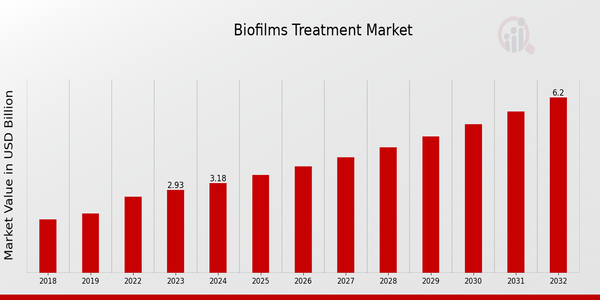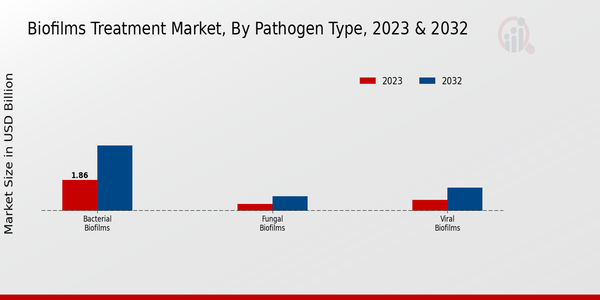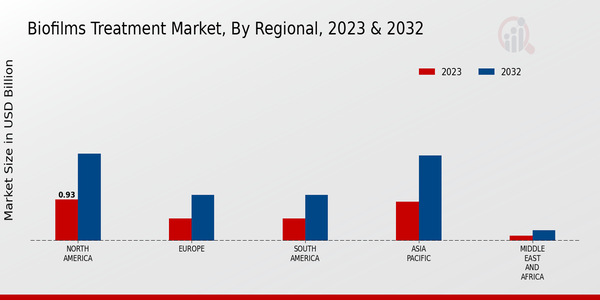Biofilms Treatment Market Overview:
As per MRFR analysis, the Biofilms Treatment Market Size was estimated at 2.11 (USD Billion) in 2023. The Biofilms Treatment Market Industry is expected to grow from 2.34 (USD Billion) in 2024 to 4.81 (USD Billion) by 2032. The Market CAGR (growth rate) is expected to be around 8.36% during the forecast period (2024 - 2032).
Key Biofilms Treatment Market Trends Highlighted
The biofilms treatment market is poised for significant growth, driven by rising healthcare-associated infections (HAIs), increasing prevalence of chronic diseases, and advancements in biofilm-targeting therapies.
The development of novel antimicrobial agents, biofilm-disrupting technologies, and diagnostic tools is creating lucrative opportunities in the market. Recent trends include the integration of artificial intelligence in biofilm research, the exploration of nanotechnology-based treatments, and the focus on personalized medicine approaches.
These innovations hold promise for improving patient outcomes and reducing the economic burden of biofilm-related infections. Key market drivers include the rising demand for effective biofilm management strategies in healthcare settings, the growing awareness of biofilm-related complications in chronic diseases, and the increasing investment in research and development activities. By leveraging these opportunities and addressing the challenges associated with biofilm treatment, industry players can capitalize on the immense potential of this market.

Source: Primary Research, Secondary Research, MRFR Database and Analyst Review
Biofilms Treatment Market Drivers
Increasing Prevalence of Biofilm-Related Infections
Biofilms are communities of microorganisms that adhere to surfaces and form a protective matrix. Biofilms are found in a wide variety of environments, including the human body. Biofilm-related infections are an increasingly important healthcare challenge because they are difficult to treat.
The increasing prevalence of biofilm-related infections is a major driver of growth in the Biofilms Treatment Market. Factors contributing to the increase in the prevalence of biofilm-related infections include: The rise of antibiotic resistance: Bacteria can form biofilms to protect themselves from antibiotics.
Because of this, biofilm-related infections are difficult to treat by conventional antibiotics. 2. The aging population: As the population ages, chronic diseases become more prevalent. Many chronic diseases weaken the immune system, which allows the bacteria to form biofilms and cause infections. 3. The increasing use of medical devices: medical devices provide a surface for bacteria to attach to, thus increasing the risk of a biofilm-related infection.
The number of medical devices and the duration with which they are used are likely to increase in the future as the population continues to age and the demand for healthcare services continues to increase. Biofilm-related infections are an important healthcare challenge around the world. The development of new and effective biofilm treatments is a key current and future priority.
Growing Awareness of Biofilms and Their Role in Disease
Increasing awareness of biofilms is known as one of the main drivers of the Biofilms Treatment Market. There are several aspects causing the increased awareness of biofilms. First, advances in research demonstrate that biofilms play a role in all types of diseases, including but not limited to chronic wounds, device-related infections and infections of the respiratory and urinary tracts.
In addition to that, biofilm diagnostics are becoming more and more common, which increases the accuracy of detecting an infection related to biofilms. Finally, it is important to note that as people become increasingly aware of the danger of biofilms, they tend to demand more and more types of biofilms treatment.
Technological Advancements in Biofilm Treatment
One of the main drivers of the Biofilms Treatment Market is technological advancements in the development of new and innovative biofilm treatments. These advancements include, but are not limited to, the following:
New antibiotics: New antibiotics are in development that are specifically developed to target bacteria in biofilms. These are more effective in killing biofilm bacteria compared to traditional antibiotics. Novel biofilm-dispersing agents: Biofilm-dispersing agents are chemicals that facilitate the dispersal of the biofilm and the bacteria contained within. As such, they help to make the biofilm bacteria more susceptible to treatment with antibiotics and/or other treatments.
Advanced wound care products: There are new advanced wound care products that contain technologies to assist in fighting biofilm. There are and will be such products that are designed for the prevention, or even treatment, of biofilm-related wound infections. Technological advancements in the field of biofilms treatment are necessary to fight the emerging threat of biofilm-related infections.
Some of the technologies discussed above are either in the process of development or have already been developed and made available to patients. Such advances on the market will further improve the outcomes of patients affected by biofilm infections.
Biofilms Treatment Market Segment Insights:
Biofilms Treatment Market Pathogen Type Insights
The Biofilms Treatment Market is further divided by pathogen type into bacterial biofilms, fungal biofilms, and viral biofilms. Bacterial biofilms held the largest market share in 2023 and will continue its dominance throughout the forecast period. This growth can be attributed to the increasing prevalence of bacterial infections and the development of new, effective treatments for those conditions.
The fungal biofilms segment will experience a quicker growth rate during the forecast period due to the exponential increase of fungal infections and the advent of new antifungal therapies on the market. Moreover, the expanding awareness of biofilms and their importance in fungal infections may result in growth of the segment.
The viral biofilms segment will experience a uniform growth rate during the forecast period, which can be attributed to the increasing extent of viral infections and an expanding offer of antiviral drugs. The main drivers behind the expansion of the market are the increase in the prevalence of biofilm-related infections, the development of new, efficient treatments for those conditions, and the increasing awareness of the community on biofilms and their role in diseases.

Source: Primary Research, Secondary Research, MRFR Database and Analyst Review
Biofilms Treatment Market Treatment Type Insights
The Biofilms Treatment Market is segmented by treatment type into antimicrobial therapy, bio-enzymatic therapy, physical disruption methods, and nanomedicine-based treatment. The largest market share in 2023 was held by the antimicrobial therapy segment, which is expected to account for the most significant market share throughout the forecast period. The growth of this segment can be explained by the rising use of antibiotics to treat biofilms. Another promising segment is bio-enzymatic therapy, which can demonstrate rapid growth in the future.
The growth of this market segment is explained by the increasing adoption of enzymatic debridement techniques to treat chronic wounds. Another segment that can achieve significant rates of growth is a physical disruption method. For example, ultrasound or laser treatment allows destruction of the biofilm with few or no adverse effects on the underlying and adjacent tissues.
A nanomedicine-based treatment is a somewhat new market segment. However, it can revolutionize the ways biofilms can be treated. Given that nanoparticles can be synthesized to target the biofilm, such therapy is a significant advantage over traditional antibiotics.
Biofilms Treatment Market End User Insights
The end user segment of the Biofilms Treatment Market is categorized into hospitals and clinics, ambulatory surgical centers, research institutes, and industrial applications. Among these, hospitals and clinics hold the largest market share due to the high prevalence of biofilm-related infections in healthcare settings. Ambulatory surgical centers are expected to witness significant growth over the forecast period owing to the increasing number of outpatient surgeries.
Research institutes are also anticipated to contribute to market growth as they play a crucial role in developing and evaluating novel biofilm treatment strategies. Industrial applications of biofilm treatment, such as in water treatment and food processing, are anticipated to gain traction as industries seek to mitigate the risks associated with biofilm formation.
Biofilms Treatment Market Application Insights
The Biofilms Treatment Market is segmented based on application into chronic wound treatment, device-associated infections, medical implant infections, and dental infections. Among these, the chronic wound treatment segment is expected to hold the largest market share in 2023, owing to the increasing prevalence of chronic wounds, such as diabetic foot ulcers and pressure sores.
The device-associated infections segment is also expected to witness significant growth due to the rising number of surgeries and the use of medical devices. The medical implant infections segment is expected to grow steadily due to the increasing demand for joint replacement surgeries and other medical implants. The dental infections segment is also expected to contribute to the growth of the market due to the rising incidence of dental caries and gum disease.
Biofilms Treatment Market Regional Insights
The Biofilms Treatment Market is segmented into North America, Europe, APAC, South America, and MEA. North America held the largest share of the market in 2023 and is expected to continue to dominate the market throughout the forecast period.
The growth of the North American market is attributed to the presence of many hospitals and clinics, as well as the increasing prevalence of biofilm-related infections. Europe is the second largest market for biofilms treatment and is expected to grow at a steady pace over the forecast period.
The growth of the European market is attributed to the increasing awareness of biofilm-related infections, as well as the growing number of government initiatives to support research and development in this area. APAC is the third largest market for biofilms treatment and is expected to grow at the fastest pace over the forecast period.
The growth of the APAC market is attributed to the increasing prevalence of biofilm-related infections in this region, as well as the growing number of hospitals and clinics. South America and MEA are expected to grow at a moderate pace over the forecast period.

Source: Primary Research, Secondary Research, MRFR Database and Analyst Review
Biofilms Treatment Market Key Players and Competitive Insights:
Major players in the biofilms treatment market are constantly striving to gain a competitive edge by developing innovative products and expanding their global reach. Leading market players are investing heavily in research and development to stay ahead of the competition.
The landscape is characterized by strategic collaborations, mergers, and acquisitions to enhance market position and expand product portfolios. Key players are also focusing on expanding their distribution networks and strengthening their relationships with healthcare providers to increase market penetration. The competitive landscape is expected to remain dynamic as new entrants emerge and existing players continue to innovate and expand their offerings.
A leading player in the market is Coloplast. The company offers a range of biofilm-disrupting technologies, including the Coloplast Biofilm Dispersal Device and the Coloplast Biofilm Prevention Kit. Coloplast has a strong global presence and distributes its products in over 100 countries worldwide. The company is committed to improving the lives of people with chronic wounds and is actively involved in research and development to advance the field of biofilm treatment.
Another key player is Johnson & Johnson. The company's Ethicon division offers a portfolio of biofilm management solutions, including the Ethicon Biofilm Management Kit and the Ethicon Biofilm Prevention Kit. Johnson & Johnson has a global reach and is a trusted provider of medical devices and healthcare products. The company is leveraging its expertise in wound care to develop innovative biofilm treatment solutions and expand its market share.
Key Companies in the Biofilms Treatment Market Include:
- Biofilm Control Systems (BCS)
- Evonik
- Henkel
- Lonza
- Microban International
- Nuvo Group
- Asepta
- BioCote
- Oxitec
- ProShield
- Purolite
- Sterilis
- RND Biotech
- HaloSource
- Ecolab
Biofilms Treatment Market Developments
The Biofilms Treatment Market size is projected to reach USD 6.2 billion by 2032, exhibiting a CAGR of 8.68% during the forecast period. Increasing prevalence of biofilm-associated infections, rising demand for effective treatment options, and growing awareness about the significance of biofilm management in healthcare settings drive market growth.
Technological advancements, including the development of novel antimicrobial agents and biofilm-dispersing enzymes, further contribute to market expansion. Strategic collaborations and mergers and acquisitions among key players are expected to shape the competitive landscape in the coming years.
Biofilms Treatment Market Segmentation Insights
Biofilms Treatment Market Pathogen Type Outlook
- Bacterial Biofilms
- Fungal Biofilms
- Viral Biofilms
Biofilms Treatment Market Treatment Type Outlook
- Antimicrobial Therapy
- Bio-enzymatic Therapy
- Physical Disruption Methods
- Nanomedicine-Based Treatment
Biofilms Treatment Market End User Outlook
- Hospitals and Clinics
- Ambulatory Surgical Centers
- Research Institutes
- Industrial Applications
Biofilms Treatment Market Application Outlook
- Chronic Wound Treatment
- Device-associated Infections
- Medical Implant Infections
- Dental Infections
Biofilms Treatment Market Regional Outlook
- North America
- Europe
- South America
- Asia Pacific
- Middle East and Africa
| Report Attribute/Metric |
Details |
| Market Size 2023 |
2.11 (USD Billion) |
| Market Size 2024 |
2.34(USD Billion) |
| Market Size 2032 |
4.81 (USD Billion) |
| Compound Annual Growth Rate (CAGR) |
8.36% (2024-2032) |
| Report Coverage |
Revenue Forecast, Competitive Landscape, Growth Factors, and Trends |
| Base Year |
2023 |
| Market Forecast Period |
2024-2032 |
| Historical Data |
2019-2023 |
| Market Forecast Units |
USD Billion |
| Key Companies Profiled |
Biofilm Control Systems (BCS), Evonik, Henkel, Lonza, Microban International, Nuvo Group, Asepta, BioCote, Oxitec, ProShield, Purolite, Sterilis, RND Biotech, HaloSource, Ecolab |
| Segments Covered |
Pathogen Type, Treatment Type, End User, Application, Region |
| Key Market Opportunities |
1. Increasing Prevalence of Biofilm related Infections 2. Advancements in Research and Development 3. Growing Awareness of Biofilm related Diseases 4. Technological Advancements in Biofilm Detection and Characterization 5. Expansion of Applications in Healthcare and Industrial Settings |
| Key Market Dynamics |
1. Rising Prevalence of Biofilm Related Infections 2. Growing Demand for Nonantibiotic Treatments 3. Technological Advancements in Biofilm Detection and Treatment |
| Countries Covered |
North America, Europe, APAC, South America, MEA |
Frequently Asked Questions (FAQ) :
The Biofilms Treatment Market was valued at USD 2.11 billion in 2023.
The CAGR of the Biofilms Treatment Market is projected to be 8.36% from 2023 to 2032.
The Biofilms Treatment Market is expected to reach USD 4.81 billion by 2032.
North America is expected to hold the largest market share in the Biofilms Treatment Market.
The medical implants segment is expected to witness the highest growth rate in the Biofilms Treatment Market.
Some of the key competitors in the Biofilms Treatment Market include 3M, Coloplast, and Medtronic.
The major factors driving the growth of the Biofilms Treatment Market include the increasing prevalence of biofilm-related infections and the growing adoption of biofilm prevention and treatment technologies.
The major challenges faced by the Biofilms Treatment Market include the lack of effective biofilm treatment options and the high cost of biofilm prevention and treatment technologies.
The major opportunities for growth in the Biofilms Treatment Market include the development of new and more effective biofilm treatment options and the increasing adoption of biofilm prevention and treatment technologies in developing countries.
The major trends shaping the Biofilms Treatment Market include the growing focus on personalized medicine and the increasing use of artificial intelligence in biofilm research and development.

















